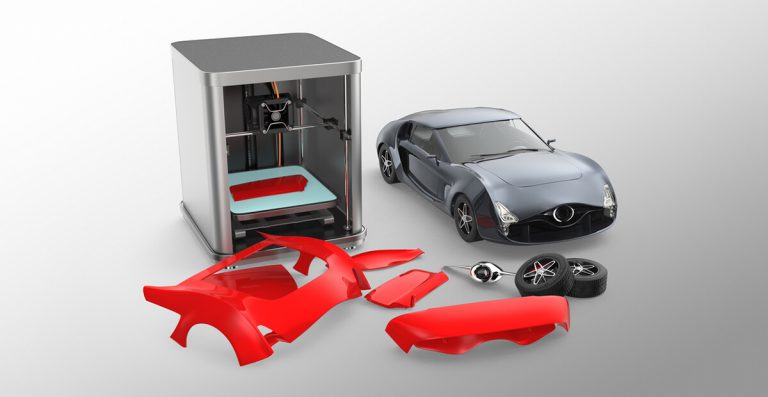3D-Printed Metamaterial Could Lead to Lighter & Safer Cars in the Future!
3D-Printed Metamaterial Could Lead to Lighter & Safer Cars in the Future!
In the near future, we could be seeing cars built with a new type of 3D-printed material that is made from polypropylene and polyethylene with carbon nanotubes. This metamaterial was designed by a team of researchers from the University of Glasgow and is capable of great impact resistance.
This material could lead to the manufacture of cars that are lighter, tougher, and even safer. What’s more, this durable structure could also see potential application in the field of marine, aerospace, industrial automotive, and renewables industries.
The metamaterials are basically cubic structures made from flexible intersecting layers of plates that can exhibit high strength and stiffness despite a huge amount of space between the plates. These spaces make metamaterial unusually lightweight.
What the Researchers Discovered?
The team of researchers discovered that by using a plastic-nanotube composite, they could create a metamaterial that exhibits advanced properties of toughness, stiffness, and strength.
The composite consists of a mixture of polyethylene and polypropylene with multi-wall carbon nanotubes.
The researchers then used this composite as the feedstock in the 3D printer. This fused the filaments and ended up creating a series of plate-lattice designs. A series of impact tests were carried out on these metamaterial designs. The researchers dropped a mass of 16.7-kg from various ranges of heights to determine the metamaterial’s ability to withstand significant physical impacts.
Tests Conducted:
The team first began by testing three types of metamaterials they designed. These materials were made in two batches — one from polyethylene and the other from polypropylene.
The third was the “hybrid” plastic metamaterial that incorporated features from the simpler designs in the first experiments from both, polypropylene and polyethylene. The hybrid design proved to be the most effective in absorbing shocks and displayed great impact resistance.
Conclusion:
With the advances in 3D printing and the implementation of plastics, researchers are finding cheaper and easier ways to design industrial-scale materials with mind-blowing properties.
One application for the new kind of metamaterial could be in the automobile industry, where designers are starving to build cars with lightweight bodies without compromising safety. The future seems promising from here on, and it’s important to note that this innovation could not have been possible without plastic!
Source:
Leave a Reply Cancel reply
Recent Posts
- Understanding The Materials That Are Used To Build Plastic Toys
- All You Need To Know About Food-grade Plastics
- A Glance At The Materials That Boost The Performance Of Plastics
- Understanding The Importance Of Exploring New Business Opportunities In The Plastic Industry
- Understanding The Importance Of Investing in R&D For The Plastic Industry
Categories
- 3D Printing
- AIPMA
- Automation
- Automobile Sector
- Bio Plastics
- Environment
- Innovations In Recycling
- Latest Innovations
- Molds & Dies
- News
- Packaging Industry
- Plastic
- Plastic Application
- Plastic Industry
- Plastic Market
- Plastic Myths
- Plastic News From The World
- Plastic Packaging
- Plastic Products
- Plastic Recycling
- Plastic Solar Cells
- Plastic Toys
- Plastic Waste
- Plastic World
- Plastics
- Plastics And Their Applications
- Plastics In Agriculture
- Plastics In Healthcare
- Plastics In Medical Industry
- Plasticulture
- Processing Machinery
- Recycling Machines
- Robotics
- Uncategorized
- Virtual Reality
Archives
- November 2023 (3)
- October 2023 (2)
- September 2023 (3)
- August 2023 (3)
- July 2023 (3)
- June 2023 (3)
- May 2023 (2)
- April 2023 (2)
- March 2023 (2)
- February 2023 (2)
- January 2023 (2)
- December 2022 (3)
- November 2022 (1)
- October 2022 (1)
- September 2022 (2)
- August 2022 (1)
- July 2022 (3)
- May 2022 (3)
- March 2022 (2)
- February 2022 (1)
- January 2022 (1)
- September 2021 (2)
- August 2021 (3)
- July 2021 (4)
- June 2021 (4)
- May 2021 (3)
- April 2021 (2)
- March 2021 (4)
- November 2019 (8)
- October 2019 (8)
- September 2019 (8)
- August 2019 (8)
- July 2019 (8)
- June 2019 (8)
- May 2019 (8)
- April 2019 (8)
- March 2019 (8)
- February 2019 (11)
- January 2019 (8)
- December 2018 (8)
- November 2018 (12)
- October 2018 (12)

